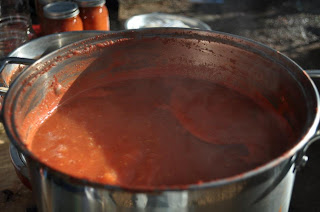Serves: 6
Ingredients:
- 1 oz dried morel mushrooms (usually come in 1/2 oz pkg at a specialty food store)
- 1/2 lb fresh cremini mushrooms (can substitute shiitake or portobello)
- 4 cups homemade chicken stock
- 6 tbsp unsalted butter
- 2 oz pancetta, diced (can substitute american bacon)
- 1/2 cup chopped shallots (3 shallots)
- 1 1/2 cups arborio rice (very important that you use arborio)
- 1/2 cup dry white wine (pinot grigio, sauvignon blanc, etc)
- 1/2 tsp saffron threads
- 1 tsp kosher salt
- 1/2 tsp fresh ground pepper
- 2/3 cup grated parmesan cheese, plus extra for serving
Place the dried morels in a bowl and pour 2 cups boiling water over them. Set aside for 30 minutes. Scoop the morels from the water with a slotted spoon, reserving the liquid. If some of the mushrooms are large, cut into 2 or 3 pieces. Pour the mushroom liquid through a coffee filter or paper towel (morels can be gritty). You should have 2 cups; if not, add water to make 2 cups. Set the mushrooms and the liquid aside separately.
Meanwhile, remove and discard the stems of the cremini and rub any dirt off the caps with a damp paper towel. Do not rinse them! Slice thickly and set aside.
In a small sauce pan heat the chicken stock with the 2 cups of reserved mushroom liquid and bring to a simmer (be careful not to boil off too much of the liquid or it won't be enough).
In a heavy-bottomed dutch oven, melt the butter and saute the pancetta and shallots over med-low heat for 5 minutes. Add the morels and porcini and saute for another 5 minutes. Add the rice and stir to coat the grains with butter. Add the wine and cook for 2 minutes. Add 2 ladles of the chicken stock mixture to the rice plus the saffron, salt and pepper. Stir and simmer over low heat until the stock is absorbed, 5 to 10 minutes.
Continue to add the stock 2 ladles at a time, stirring every few minutes. Each time, cook until the mixture seems a little dry before adding more of the stock mixture. Continue until the rice is cooked through, but still al dente (not soggy) about 25-30 minutes total. When done, the risotto should be thick and creamy and not at all dry. Off the heat, stir in the parmesan cheese. Serve hot in bowls with extra cheese on top!

































